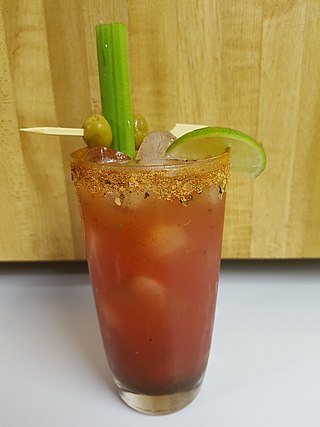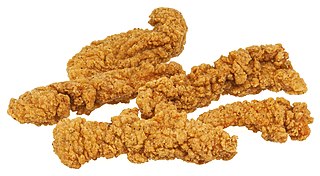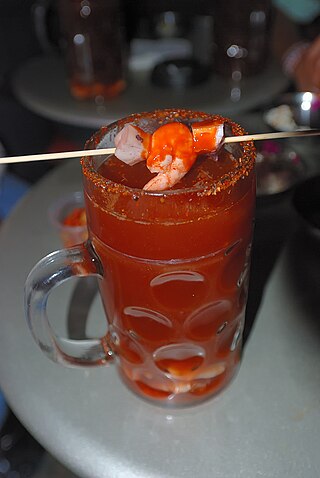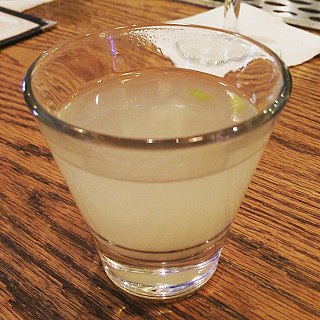
Chocolate milk is a type of flavoured milk made by mixing cocoa solids with milk. It is a food pairing in which the milk's mouthfeel masks the dietary fibres of the cocoa solids.

Guava is a common tropical fruit cultivated in many tropical and subtropical regions. The common guava Psidium guajava is a small tree in the myrtle family (Myrtaceae), native to Mexico, Central America, the Caribbean and northern South America. The name guava is also given to some other species in the genus Psidium such as strawberry guava and to the pineapple guava, Feijoa sellowiana. In 2019, 55 million tonnes of guavas were produced worldwide, led by India with 45% of the total. Botanically, guavas are berries.

Barq's is an American brand of root beer created by Edward Barq and bottled since the beginning of the 20th century. It is owned by the Coca-Cola Company. It was known as "Barq's Famous Olde Tyme Root Beer" until 2012. Some of its formulations contain caffeine.

Cheez Whiz is a brand of processed cheese sauce or spread produced by Kraft Foods. It was developed by a team led by food scientist Edwin Traisman (1915–2007). It was first sold in 1952, and with some changes in formulation continues to be in production today.

A Caesar is a cocktail created and consumed primarily in Canada. It typically contains vodka, Clamato, hot sauce, and Worcestershire sauce, and is served with ice in a large, celery salt-rimmed glass, typically garnished with a stalk of celery and wedge of lime. What distinguishes it from a Bloody Mary is the inclusion of clam broth. The cocktail may also be contrasted with the Michelada, which has similar flavouring ingredients but uses beer instead of vodka. Festivals dedicated to the cocktail are held in many cities, with the largest in Calgary. The first liquor store dedicated to the Caesar opened on July 1 2023 in Calgary, Alberta.

Clamato, , is a commercial drink made of reconstituted tomato juice concentrate and sugar, which is flavored with spices, dried clam broth and MSG. It is made by Mott's. The name is a portmanteau of clam and tomato. It is also referred to colloquially as "clamato juice". It is consumed in Canada, Mexico, and the United States, to a lesser extent. It is very often mixed with alcohol to make a Caesar, a drink similar to a Bloody Mary.

Cranberry juice is the liquid juice of the cranberry – a fruit recognized for its bright red color, tart taste, and versatility for product manufacturing. Major cranberry products include cranberry juice, dried cranberry, cranberry sauce, frozen cranberry, cranberry powder, and dietary supplements containing cranberry extracts.

Burger Rings are a type of corn-based, burger-flavoured Australian snack food distributed by The Smith's Snackfood Company, which, in turn is owned by PepsiCo.

Buttermilk Crispy Tenders were chicken strips sold by the international fast food restaurant chain McDonald's in the United States and Canada. Chicken Selects were introduced in early 1998 for a limited time and offered again in early 2002 and late 2003 and then permanently starting in 2004. In the UK, they were launched on the "Pound Saver Menu", which offers various menu items for £0.99.

Lea & Perrins (L&P) is a United Kingdom-based subsidiary of Kraft Heinz, originating in Worcester, England where it continues to operate. It is best known as the manufacturer of Lea & Perrins Worcestershire sauce, a condiment first invented and sold in 1837 by chemists John Wheeley Lea and William Henry Perrins from Broad Street, Worcester.

A michelada is a Mexican drink made with beer, lime juice, assorted sauces, spices, and chili peppers. It is served in a chilled, salt-rimmed glass. There are numerous variations of this beverage throughout Mexico.

Prune juice is a fruit juice derived from prunes that have been rehydrated. It is a mass-produced product that is often produced using a hot extraction method, and juice concentrate is typically produced using a low-temperature extraction method. It may be used as a dietary supplement to act as a laxative. It is also sometimes used as a flavor enhancer in tobacco products. It is an ingredient in many cocktails, such as the Purple Dragon, or Constipolitan.

Preserved lemon or lemon pickle is a condiment that is common in the cuisines of Indian subcontinent and Morocco. It was also found in 18th-century English cuisine.
A low sodium diet is a diet that includes no more than 1,500 to 2,400 mg of sodium per day.

Pineapple juice is a juice made from pressing the natural liquid out from the pulp of the pineapple. Numerous pineapple varieties may be used to manufacture commercial pineapple juice, the most common of which are Smooth Cayenne, Red Spanish, Queen, and Abacaxi. In manufacturing, pineapple juice is typically canned.

A Bloody Mary is a cocktail containing vodka, tomato juice, and other spices and flavorings including Worcestershire sauce, hot sauces, garlic, herbs, horseradish, celery, olives, pickled vegetables, salt, black pepper, lemon juice, lime juice and celery salt. Some versions of the drink, such as the "surf 'n turf" Bloody Mary, include shrimp and bacon as garnishes. In the United States, it is usually consumed in the morning or early afternoon, and is popular as a hangover cure.

Fried potatoes are a dish or a component of other dishes essentially consisting of potatoes which have been fried or deep-fried in hot cooking oil often with the addition of salt and other seasonings. They are often served as a side dish.

Cucumber juice is the juice derived from cucumbers produced by squeezing or pressing it. Cucumbers are 98% water.

Clam juice is a broth derived from steamed clams, which can be consumed on its own or used as an ingredient in various dishes and beverages.

Stewed tomatoes is a dish made by cooking tomatoes in a stew. It is often cooked with garlic and herbs, and consumed with bread or meat. It is eaten as either a main dish or a side dish. Stewed tomatoes are sometimes prepared in the United States on occasions such as Thanksgiving.






















